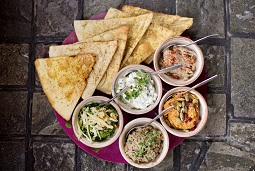Georgia in International Media / Humble Magic in Georgian Capital’s Restaurant Renaissance

When the chef Meriko Gubeladze opened Shavi Lomi, she recalled that Tbilisi was “starving for small, homey restaurants with good food.” That was 2011, and the quality of Georgian cuisine — known for its lavish use of spices and aromatic herbs influenced by travelers along the Silk Road — wasn’t the problem, but the uninviting establishments and menu selections — hangovers from the cookie-cutter days of the Soviet era — were. Artery-clogging khachapuri, the cheesy bread often likened to pizza, still tempted. But at every meal? How often could a person eat walnut-paste-stuffed vegetables and a lamb stew called chakapuli, a favorite dish of Stalin. Four years after Shavi Lomi updated these seasonal family recipes, serving them in a cozy atmosphere, other restaurants soon followed suit.
Tbilisi today has a reimagined dining scene. Instead of the same standard-issue 10 dishes, post-Soviet restaurants are bringing a humble magic to dining in Georgia’s capital city, with a focus on all things organic.
If sumptuous flavors and a living-room-like setting with bright carpets and heirloom batik tablecloths were Shavi Lomi’s contributions, promoting organic food and natural wine was the province of Vino Underground, a popular natural-wine bar and salon just around the corner.
Between those two pioneering forces, a peaceful culinary revolution began. More than a half-dozen homey restaurants have opened with prideful Georgian menus proclaiming organic status for both food and wine. With the current exchange rate, the experience is not only exciting, but also often a bargain.
This culinary fever also has spread from the traditional tourist area, the sandstone crumbling Old City, to Tbilisi’s more contemporary quarters across the Kura River. Now bargain hunters heading to the Dry Bridge Market, an enclave to buy drinking horns and Soviet memorabilia, can reward their appetite without compromise. Shavi Lomi has relocated there. Another hot spot is Barbarestan, housed in an old butcher shop with meat hooks still visible and caged singing canaries. Family-owned, the restaurant drew its menu from Georgia’s beloved 19th-century cookbook by Barbare Jorjadze, who celebrated the Silk Road influence of her country’s cuisine. While her cookbook remains a strong influence on other local dining spots too, Barbarestan’s fare shows fealty in all details. Ghee, clarified butter, is used exclusively. The nadugi — a typical fresh cheese spread and stuffing — gets a vegan spin when substituting Ms. Jorjadze’s recipe for pumpkinseed milk.
But the culinary action has especially taken hold in the heart of the Old City. There, behind the gilded and imposing St. George statue in Freedom Square, three restaurants have opened. Strolling the quiet streets, this visitor was pleasantly surprised to come across Ezo, tucked in a residential courtyard. Ezo, its name meaning yard, opened two years ago, and while it’s rustic, don’t be fooled. One can feast like the 12th-century Queen Tamara there for $25 per person. Many of the flavorful organic ingredients are from the owners’ farm.
Proletariat options like the salt-cured jonjoli (bladdernut flowers), staples on any Georgian table, get an unusual twist with familiar walnut garlic sauce. Tender veal in herbs is a customer magnet. Wash it down with glugs of family chacha (grappa) for an authentic accent. Walk another few minutes, on uneven cobblestones and broken sidewalks, past unmarked boutiques and fruit stalls that never seem to shut, and you will find the more upscale Azarphesha, now four years old. With walls of museum-worthy displays showcasing ancient drinking vessels, the restaurant remains of the moment. Yet with its mix of traditional tablecloths and fresh wild posies, the room couldn’t feel less pretentious, especially when a table spontaneously burst out in the traditional, emotional polyphonic village songs, as often happens.
Husband and wife Nino and Luarsab Togonidze joined with a friend, the American expatriate painter and winemaker John Wurdeman, and fashioned a fascinating Georgian fusion menu. Their riff on the country’s strong pickle culture is emblematic; take the kimchee-like banana peppers with local-toasted sunflower-seed oil. Even with its hints of Peru or Mexico, it tastes of home. From its geek-worthy wine list, all organic and natural, to its foraged juniper gins, the philosophy is uncompromising.
In December, the three opened a new restaurant, Poliphonia, considered one of the best eating spots in town.
Reflecting on the city’s restaurant renaissance, Mr. Togonidze said the country’s recent political calm was only part of the story: “Compounded with a new generation who have grown up in freedom with the excitement about natural wine, how could that energy not spill over to the table?” he said. “After all, in Georgia, wine and food have always been intertwined.”
Source: NYTimes.com
